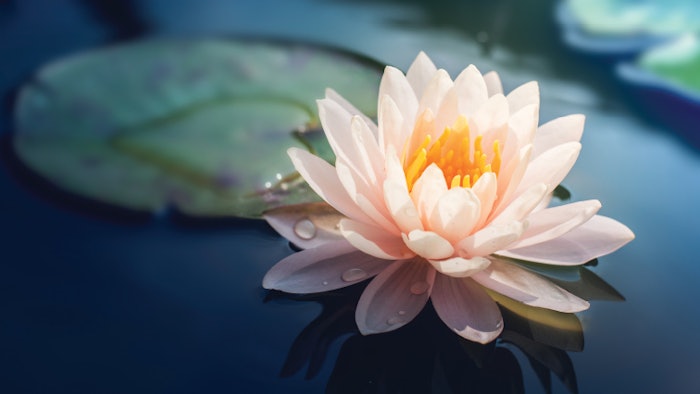
Water lilies, or Nymphaea, evoke the vision of decorative water gardens topped by thick, green, drifting round pads with pops of white and spiky flowers. They symbolize purity, fertility, hope, rebirth, wellness and peace, and nearly all ancient cultures have associated the white lilies with gods and spirituality.1
The scientific name, Nymphaea, comes from the Greek word nymph that according to mythology, refers to a feminine spirit inhabiting water bodies such as wells, waterways and springs. Another legend reports the water lily was once a star that fell from the sky onto the water and changed into a flower.2
Nymphaea refers to a genus of aquatic plants that grows in shallow water, characterized by floating leaves at the surface, large root-like stems beneath and solitary flowers of various colors. There are 74 species found in temperate and tropical regions, of which many are cultivated;3 the common North American white water lily, or pond lily, is N. odorata, while the European white water lily is N. alba.3 Nymphaea are closely related to Nelumbo (lotus) plants, both of which are symbolic in ancient and modern times, celebrated for their beauty and represented in art and religion.4
Long History
Water lilies have been classified as paleoherbs, with a history that long pre-dates humans. Fossilized seeds from the genus Barclayopsis have been found from as early as the Maastrichtian (Late Cretaceous) period – approximately 100.5-66 million years ago (Ma, or mega annum). Fossils from the Eocene (~55.8 to 33.9 Ma) and Miocene (~23.03 to 5.333 Ma) periods of the leaves and flowers also have been identified. 5
Water lilies appeared in ancient Egyptian temples atop columns, and priests and rulers were often buried with necklaces of water lily blossoms, as the flowers symbolized resurrection from the dead.6 Some Nymphaea species have also reportedly been used as hallucinogens; records have highlighted their uses in Egyptian and Mayan rituals.7
Hindu and Buddhist traditions regard the lotus as the womb of gods and as a symbol of the spiritual ideal. At the beginning of the nineteenth century, when water gardens gained popularity in Europe, water lilies were often featured in them. The plants also were depicted in art; for example, in the artist Monet’s iconic painting.6
Related: Jar Deconstructed: Lotus
Traditional Uses
Besides their religious and cultural significance, water lilies can provide an important source of food and other economic products. The seeds and rhizomes of Nymphaea plants can be eaten.8 The tubers and lotus are edible when properly prepared, and have been an important starch crop in Asia and North America. The seeds of many species have a fleshy outer covering that is also edible.6
Additionally, the tubers have been used as a source for dye and medicinal benefits.6 Indeed, water lilies have a history in traditional medicine, where all parts were used. The root was taken by monks and nuns for hundreds of years as an anaphrodisiac by crushing and mixing it with wine. Other uses range from reducing pain and inflammation, to acting as an astringent, cardiotonic and demulcent. It also is reported to have sedative and calming effects on the nervous system and can be used to treat insomnia, anxiety and similar disorders.9
The dried roots and rhizomes of white water lily are taken orally to treat gastrointestinal issues such as diarrhea, genital and bronchial conditions, and for burns and boils, although limited scientific evidence supports these uses.9, 10 The leaves and roots have been used externally as infusions to treat lesions and inflammation associated with mucous membranes, and as poultices to treat dermatological conditions.9
Continue reading about water lily's benefits in the spa in our June Digital Magazine...
Rachel Grabenhofer is the managing scientific editor of Cosmetics & Toiletries, Skin Inc.’s sister brand for cosmetic chemists. She’s a member of the Skin Microbiome Council and Society of Cosmetic Chemists, and for several years, led judging panels to honor the best ingredients in cosmetics.











